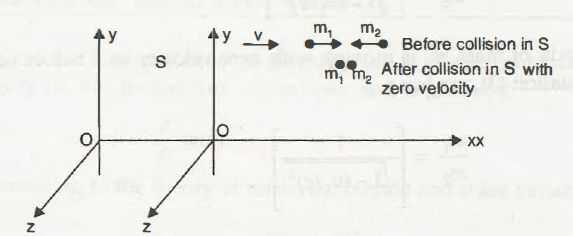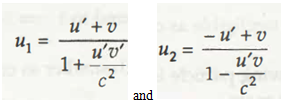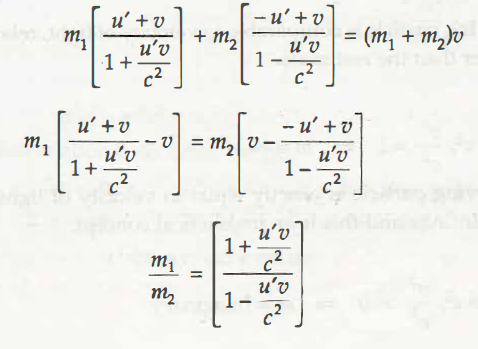Variation of Mass with Velocity Notes for Engineering Physics:
According to Einstein, the mass of the body in motion is different from the mass of the body at rest. We consider two inertial frames S and S’ as in Figure

We now consider the collision of two bodies in S’ and view it from the S. Let the two particles of masses m1 and m2 are travelling with velocity u ‘ and-u ‘ parallel to x-axis in S’. The two bodies collide and after collision they coalesced into one body.
In System S: Before Collision:
Mass of bodies are m1 and m2• Let the their velocities are u1 and u2 respectively.
In System S: After Collision:
Mass of the coalesced body is (m1+ m2) and the velocity Is v .
Using law of addition of velocities;
Applying the principle of conservation of momentum of the system before and after the
collision, we have,
m1 u1 +m2 u2 = (m1 +m2)v
Now, using equations (1) and (2), we have
M1/m2 = [√ 1-(u2 /c)2 /√ 1-(u1 /c)2 ]
Let the body of mass m2 is moving with zero velocity in S before collision, i.e., u2 = 0,
hence, using equation (3), we have,
m1 /m2 = 1 / √ 1-(u1/c)2
Using common notation as m1= m, m2 = m 0 , u1 = v, we have by using equation (4).
This is the relativistic formula for variation of mass with velocity, where m 0 is the rest mass and m is the relativistic mass of the body. There are a large numbers of experimental observations of this enhancement of mass of particles in high energy physics
I. When v << c
v2 << c2, v 2 / c2 is negligible as compared to 1 => c m =m0
When velocity of the moving particle is much smaller as compared to velocity of light,
relativistic mass equals the rest mass.
II. When v= c
V2 =c2 ,v2 /c2 =1 => [1- v2 /c2 ] ,< 1 => m >m0
When velocity of the moving particle is comparable to velocity of light, relativistic mass of the body appears to be greater than the rest mass.
III. When v = c
V2 =c2 , v2 /c2 =1 => m
When velocity of the moving particle is exactly equal to velocity of light, relativistic mass of the body appears to be infinite and this is an impractical concept.
IV. When v > c
V2 > > c2 ,v2 /c2 > 0 m = Imaginary
When velocity of the moving particle is greater as compared to velocity of light., relativistic mass becomes imaginary and this is an impractical concept.




sir ,
please explain it
In the relativistic formula of the variation of mass with velocity ,
1) what is the rest mass?
2) what is the relativistic mass?
3) u=v means?